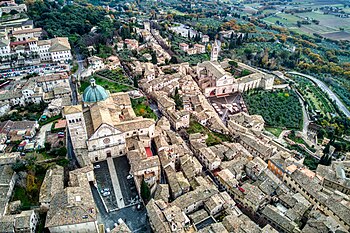
Back كاتدرائيه اسيزى ARZ Kathedrale von Assisi German Catedral de San Rufino (Asís) Spanish Cathédrale d'Assise French Duomo San Rufino Frisian Katedral Assisi ID Cattedrale di San Rufino Italian 산 루피노 대성당 Korean Катедрала Сан Руфино Macedonian Katedra w Asyżu Polish


Assisi Cathedral (Italian: Cattedrale di Assisi or Cattedrale di San Rufino di Assisi), dedicated to San Rufino (Rufinus of Assisi), is a major church in Assisi, Italy. This stately church in Umbrian Romanesque style was the third church built on the same site to contain the remains of bishop Rufinus of Assisi, martyred in the 3rd century. The construction was started in 1140 to the designs by Giovanni da Gubbio, as attested by the wall inscription visible inside the apse. He may be the same Giovanni who designed the rose-window on the façade of Santa Maria Maggiore in 1163.
The cathedral has been important in the history of the Franciscan order. In this church Saint Francis of Assisi (1182), Saint Clare (1193), and many of their original disciple, as well as Emperor Frederick II, were baptised. It was on hearing Francis preaching in this church in 1209 that Clare became deeply touched by his message and realized her calling. Tommaso da Celano related[1] that once Saint Francis was witnessed praying in this church while, at the same time, he was seen jumping on a chariot of fire in the Porziuncola. In 1228, while he was in Assisi for the canonization of Saint Francis, Pope Gregory IX consecrated the high altar. Pope Innocent IV inaugurated the finished church in 1253.
As of 1986 it is a co-cathedral of the Roman Catholic Diocese of Assisi-Nocera Umbra-Gualdo Tadino.
- ^ Tommaso, Vita I, chap. XVIII.